Accounting Assignments: Goodwill & More
VerifiedAdded on 2020/05/16
|10
|1008
|85
AI Summary
This assignment delves into various accounting concepts. It examines the amortization of goodwill, explores its transition from mandatory to an optional practice, and compares it with the more practical method of impairment testing. The document also tackles present value calculations related to debentures and outlines percentage completion methods for recording revenue in construction projects. Finally, it discusses AASB 116's guidance on revaluing property, plant, and equipment.
Contribute Materials
Your contribution can guide someone’s learning journey. Share your
documents today.
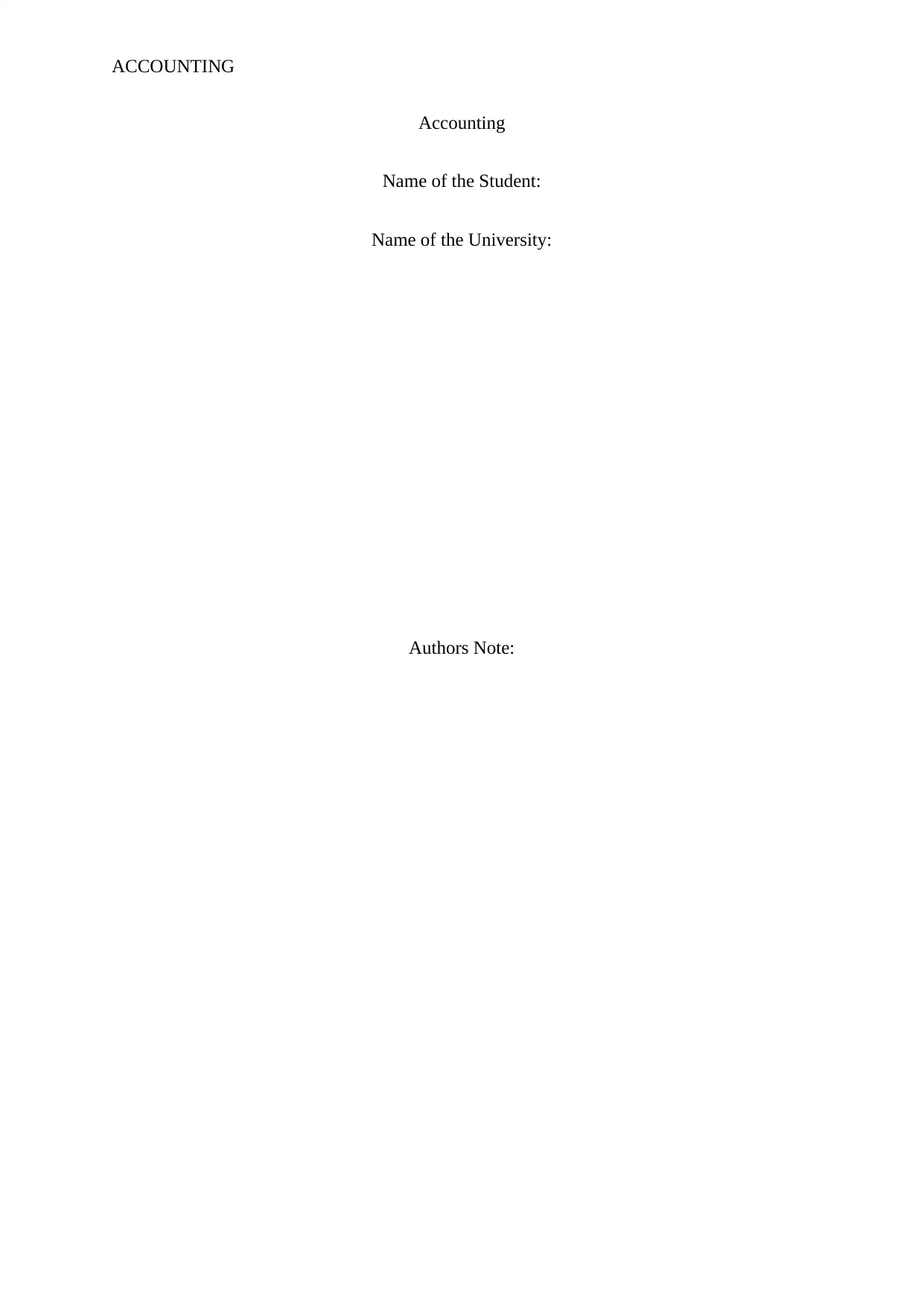
ACCOUNTING
Accounting
Name of the Student:
Name of the University:
Authors Note:
Accounting
Name of the Student:
Name of the University:
Authors Note:
Secure Best Marks with AI Grader
Need help grading? Try our AI Grader for instant feedback on your assignments.
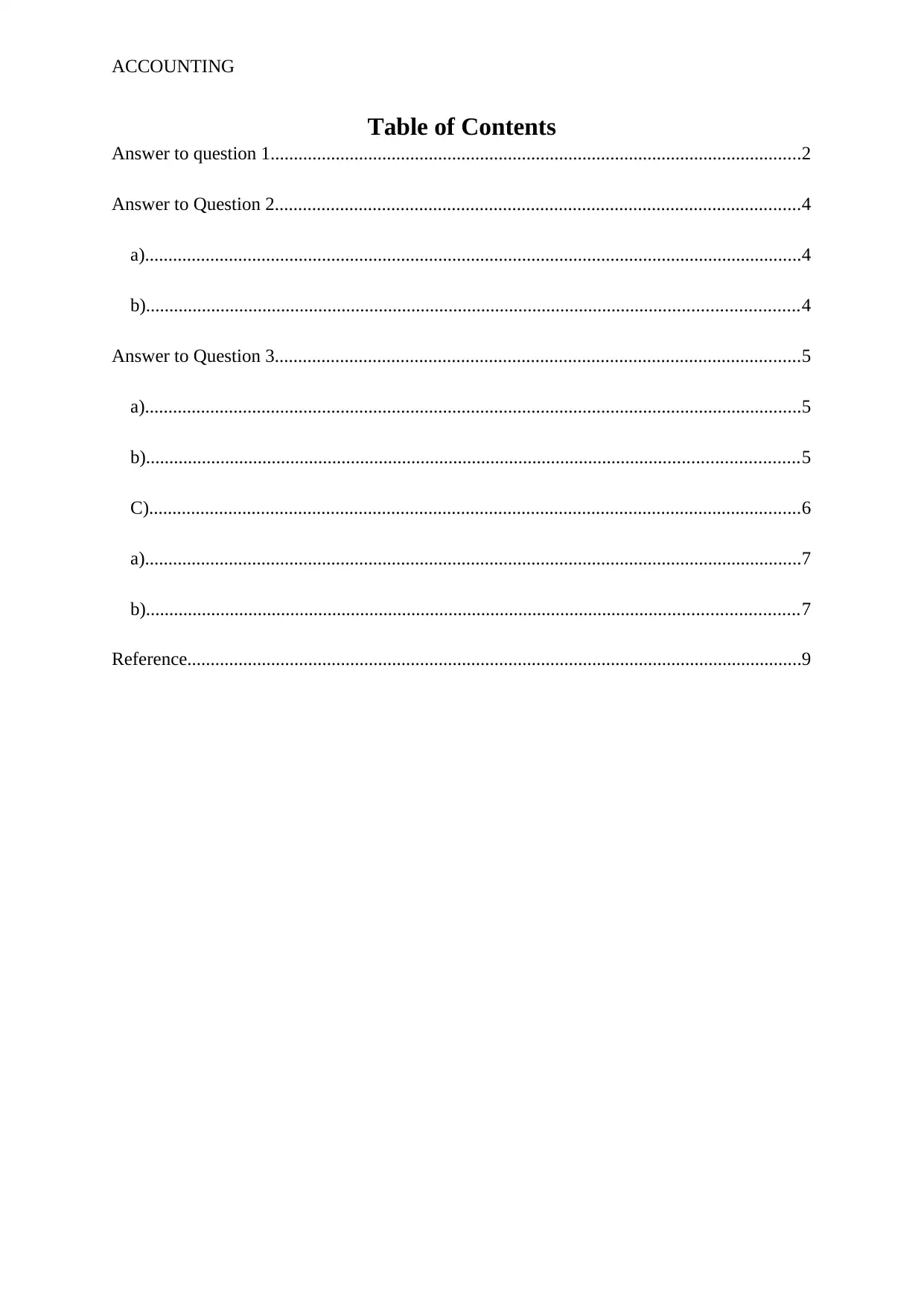
ACCOUNTING
Table of Contents
Answer to question 1..................................................................................................................2
Answer to Question 2.................................................................................................................4
a).............................................................................................................................................4
b)............................................................................................................................................4
Answer to Question 3.................................................................................................................5
a).............................................................................................................................................5
b)............................................................................................................................................5
C)............................................................................................................................................6
a).............................................................................................................................................7
b)............................................................................................................................................7
Reference....................................................................................................................................9
Table of Contents
Answer to question 1..................................................................................................................2
Answer to Question 2.................................................................................................................4
a).............................................................................................................................................4
b)............................................................................................................................................4
Answer to Question 3.................................................................................................................5
a).............................................................................................................................................5
b)............................................................................................................................................5
C)............................................................................................................................................6
a).............................................................................................................................................7
b)............................................................................................................................................7
Reference....................................................................................................................................9
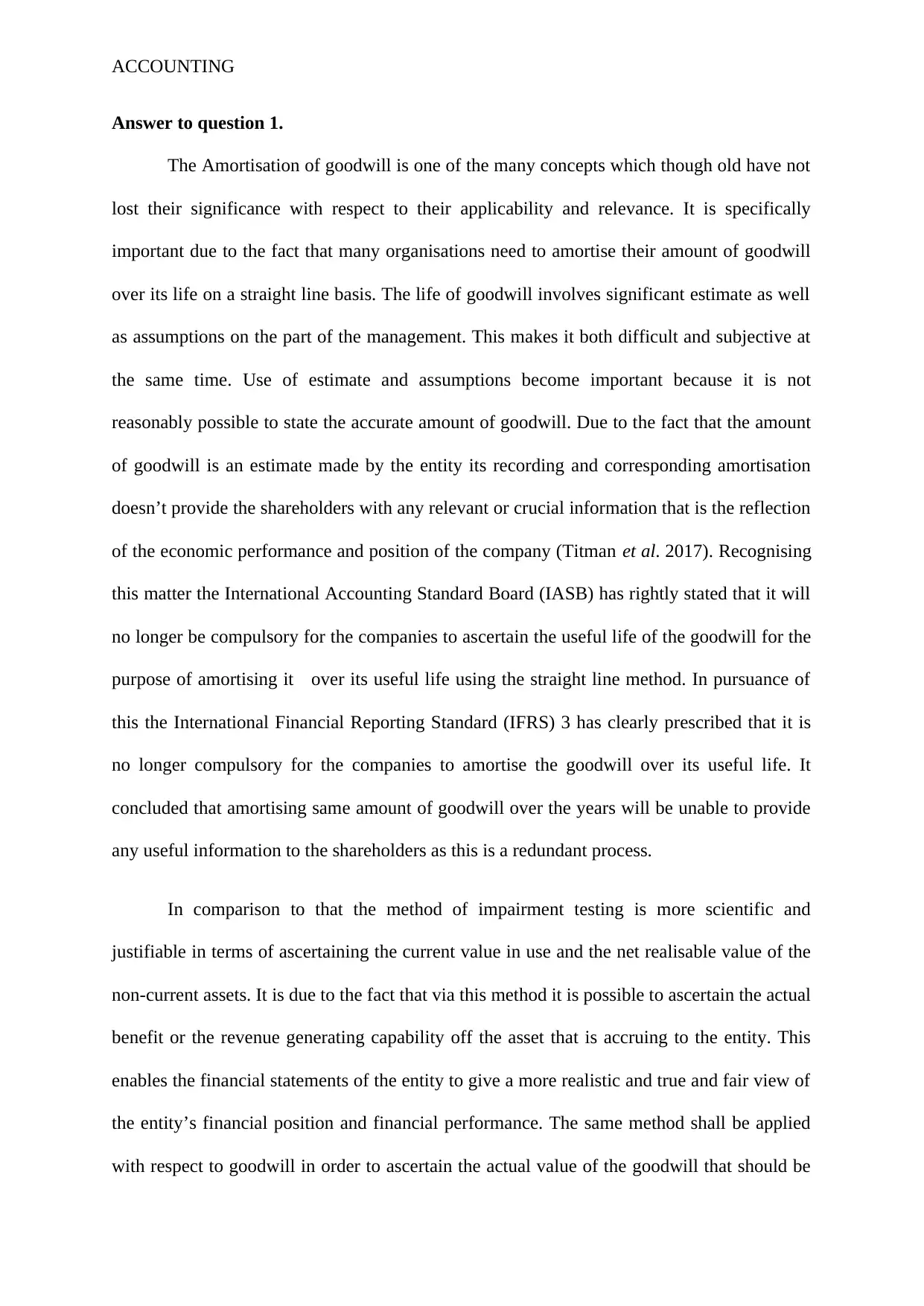
ACCOUNTING
Answer to question 1.
The Amortisation of goodwill is one of the many concepts which though old have not
lost their significance with respect to their applicability and relevance. It is specifically
important due to the fact that many organisations need to amortise their amount of goodwill
over its life on a straight line basis. The life of goodwill involves significant estimate as well
as assumptions on the part of the management. This makes it both difficult and subjective at
the same time. Use of estimate and assumptions become important because it is not
reasonably possible to state the accurate amount of goodwill. Due to the fact that the amount
of goodwill is an estimate made by the entity its recording and corresponding amortisation
doesn’t provide the shareholders with any relevant or crucial information that is the reflection
of the economic performance and position of the company (Titman et al. 2017). Recognising
this matter the International Accounting Standard Board (IASB) has rightly stated that it will
no longer be compulsory for the companies to ascertain the useful life of the goodwill for the
purpose of amortising it over its useful life using the straight line method. In pursuance of
this the International Financial Reporting Standard (IFRS) 3 has clearly prescribed that it is
no longer compulsory for the companies to amortise the goodwill over its useful life. It
concluded that amortising same amount of goodwill over the years will be unable to provide
any useful information to the shareholders as this is a redundant process.
In comparison to that the method of impairment testing is more scientific and
justifiable in terms of ascertaining the current value in use and the net realisable value of the
non-current assets. It is due to the fact that via this method it is possible to ascertain the actual
benefit or the revenue generating capability off the asset that is accruing to the entity. This
enables the financial statements of the entity to give a more realistic and true and fair view of
the entity’s financial position and financial performance. The same method shall be applied
with respect to goodwill in order to ascertain the actual value of the goodwill that should be
Answer to question 1.
The Amortisation of goodwill is one of the many concepts which though old have not
lost their significance with respect to their applicability and relevance. It is specifically
important due to the fact that many organisations need to amortise their amount of goodwill
over its life on a straight line basis. The life of goodwill involves significant estimate as well
as assumptions on the part of the management. This makes it both difficult and subjective at
the same time. Use of estimate and assumptions become important because it is not
reasonably possible to state the accurate amount of goodwill. Due to the fact that the amount
of goodwill is an estimate made by the entity its recording and corresponding amortisation
doesn’t provide the shareholders with any relevant or crucial information that is the reflection
of the economic performance and position of the company (Titman et al. 2017). Recognising
this matter the International Accounting Standard Board (IASB) has rightly stated that it will
no longer be compulsory for the companies to ascertain the useful life of the goodwill for the
purpose of amortising it over its useful life using the straight line method. In pursuance of
this the International Financial Reporting Standard (IFRS) 3 has clearly prescribed that it is
no longer compulsory for the companies to amortise the goodwill over its useful life. It
concluded that amortising same amount of goodwill over the years will be unable to provide
any useful information to the shareholders as this is a redundant process.
In comparison to that the method of impairment testing is more scientific and
justifiable in terms of ascertaining the current value in use and the net realisable value of the
non-current assets. It is due to the fact that via this method it is possible to ascertain the actual
benefit or the revenue generating capability off the asset that is accruing to the entity. This
enables the financial statements of the entity to give a more realistic and true and fair view of
the entity’s financial position and financial performance. The same method shall be applied
with respect to goodwill in order to ascertain the actual value of the goodwill that should be
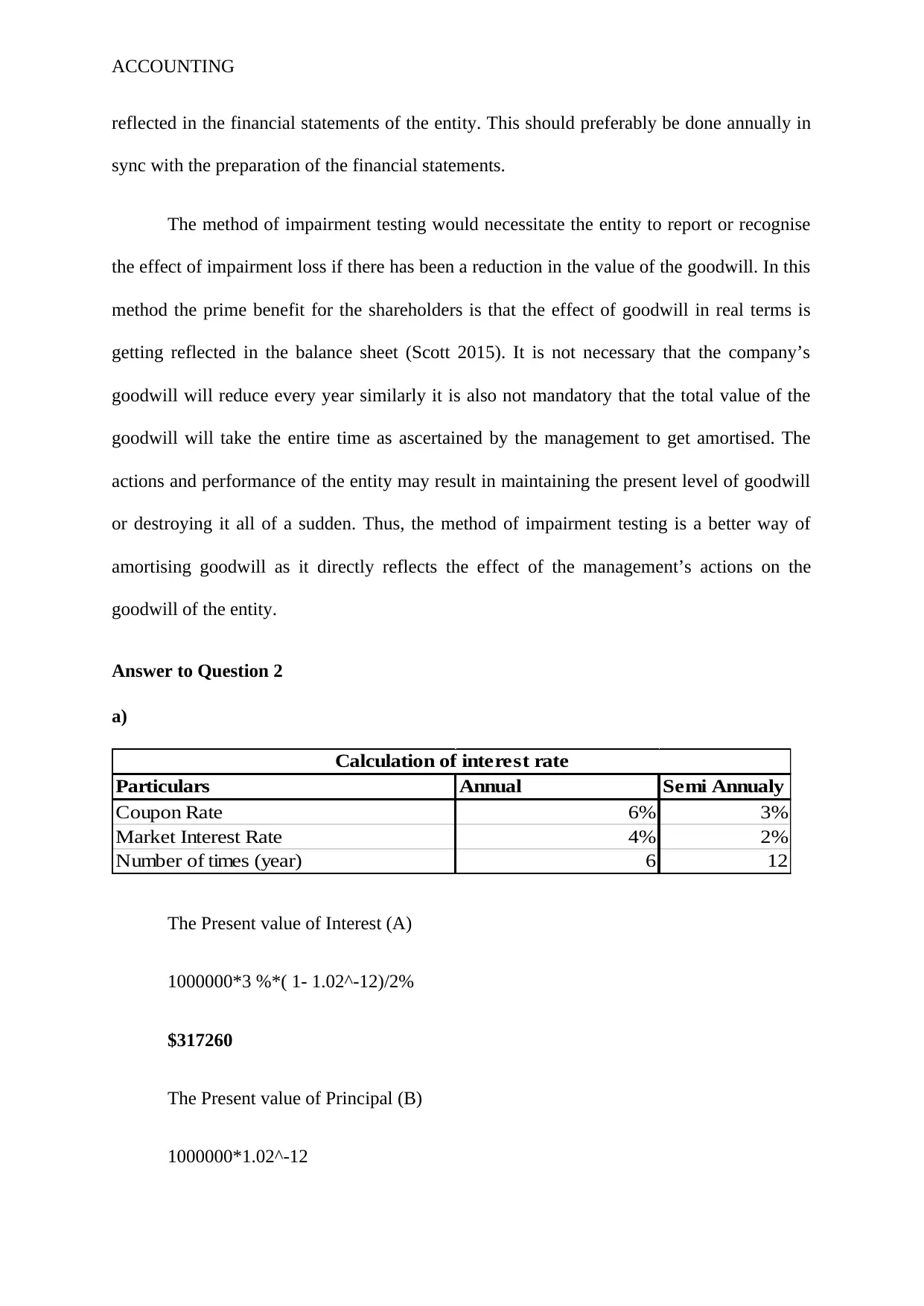
ACCOUNTING
reflected in the financial statements of the entity. This should preferably be done annually in
sync with the preparation of the financial statements.
The method of impairment testing would necessitate the entity to report or recognise
the effect of impairment loss if there has been a reduction in the value of the goodwill. In this
method the prime benefit for the shareholders is that the effect of goodwill in real terms is
getting reflected in the balance sheet (Scott 2015). It is not necessary that the company’s
goodwill will reduce every year similarly it is also not mandatory that the total value of the
goodwill will take the entire time as ascertained by the management to get amortised. The
actions and performance of the entity may result in maintaining the present level of goodwill
or destroying it all of a sudden. Thus, the method of impairment testing is a better way of
amortising goodwill as it directly reflects the effect of the management’s actions on the
goodwill of the entity.
Answer to Question 2
a)
Particulars Annual Semi Annualy
Coupon Rate 6% 3%
Market Interest Rate 4% 2%
Number of times (year) 6 12
Calculation of interest rate
The Present value of Interest (A)
1000000*3 %*( 1- 1.02^-12)/2%
$317260
The Present value of Principal (B)
1000000*1.02^-12
reflected in the financial statements of the entity. This should preferably be done annually in
sync with the preparation of the financial statements.
The method of impairment testing would necessitate the entity to report or recognise
the effect of impairment loss if there has been a reduction in the value of the goodwill. In this
method the prime benefit for the shareholders is that the effect of goodwill in real terms is
getting reflected in the balance sheet (Scott 2015). It is not necessary that the company’s
goodwill will reduce every year similarly it is also not mandatory that the total value of the
goodwill will take the entire time as ascertained by the management to get amortised. The
actions and performance of the entity may result in maintaining the present level of goodwill
or destroying it all of a sudden. Thus, the method of impairment testing is a better way of
amortising goodwill as it directly reflects the effect of the management’s actions on the
goodwill of the entity.
Answer to Question 2
a)
Particulars Annual Semi Annualy
Coupon Rate 6% 3%
Market Interest Rate 4% 2%
Number of times (year) 6 12
Calculation of interest rate
The Present value of Interest (A)
1000000*3 %*( 1- 1.02^-12)/2%
$317260
The Present value of Principal (B)
1000000*1.02^-12
Secure Best Marks with AI Grader
Need help grading? Try our AI Grader for instant feedback on your assignments.
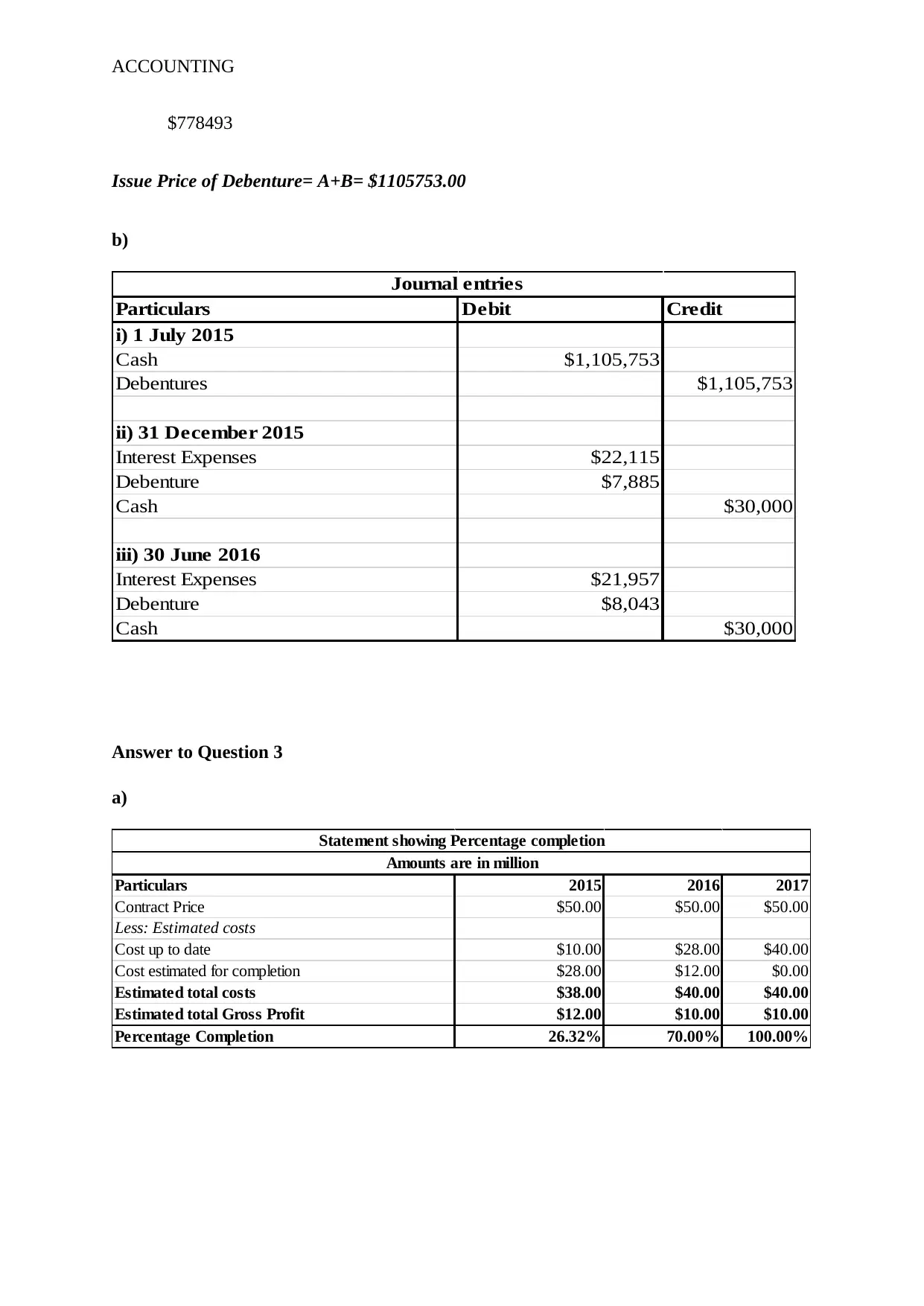
ACCOUNTING
$778493
Issue Price of Debenture= A+B= $1105753.00
b)
Particulars Debit Credit
i) 1 July 2015
Cash $1,105,753
Debentures $1,105,753
ii) 31 December 2015
Interest Expenses $22,115
Debenture $7,885
Cash $30,000
iii) 30 June 2016
Interest Expenses $21,957
Debenture $8,043
Cash $30,000
Journal entries
Answer to Question 3
a)
Particulars 2015 2016 2017
Contract Price $50.00 $50.00 $50.00
Less: Estimated costs
Cost up to date $10.00 $28.00 $40.00
Cost estimated for completion $28.00 $12.00 $0.00
Estimated total costs $38.00 $40.00 $40.00
Estimated total Gross Profit $12.00 $10.00 $10.00
Percentage Completion 26.32% 70.00% 100.00%
Statement showing Percentage completion
Amounts are in million
$778493
Issue Price of Debenture= A+B= $1105753.00
b)
Particulars Debit Credit
i) 1 July 2015
Cash $1,105,753
Debentures $1,105,753
ii) 31 December 2015
Interest Expenses $22,115
Debenture $7,885
Cash $30,000
iii) 30 June 2016
Interest Expenses $21,957
Debenture $8,043
Cash $30,000
Journal entries
Answer to Question 3
a)
Particulars 2015 2016 2017
Contract Price $50.00 $50.00 $50.00
Less: Estimated costs
Cost up to date $10.00 $28.00 $40.00
Cost estimated for completion $28.00 $12.00 $0.00
Estimated total costs $38.00 $40.00 $40.00
Estimated total Gross Profit $12.00 $10.00 $10.00
Percentage Completion 26.32% 70.00% 100.00%
Statement showing Percentage completion
Amounts are in million
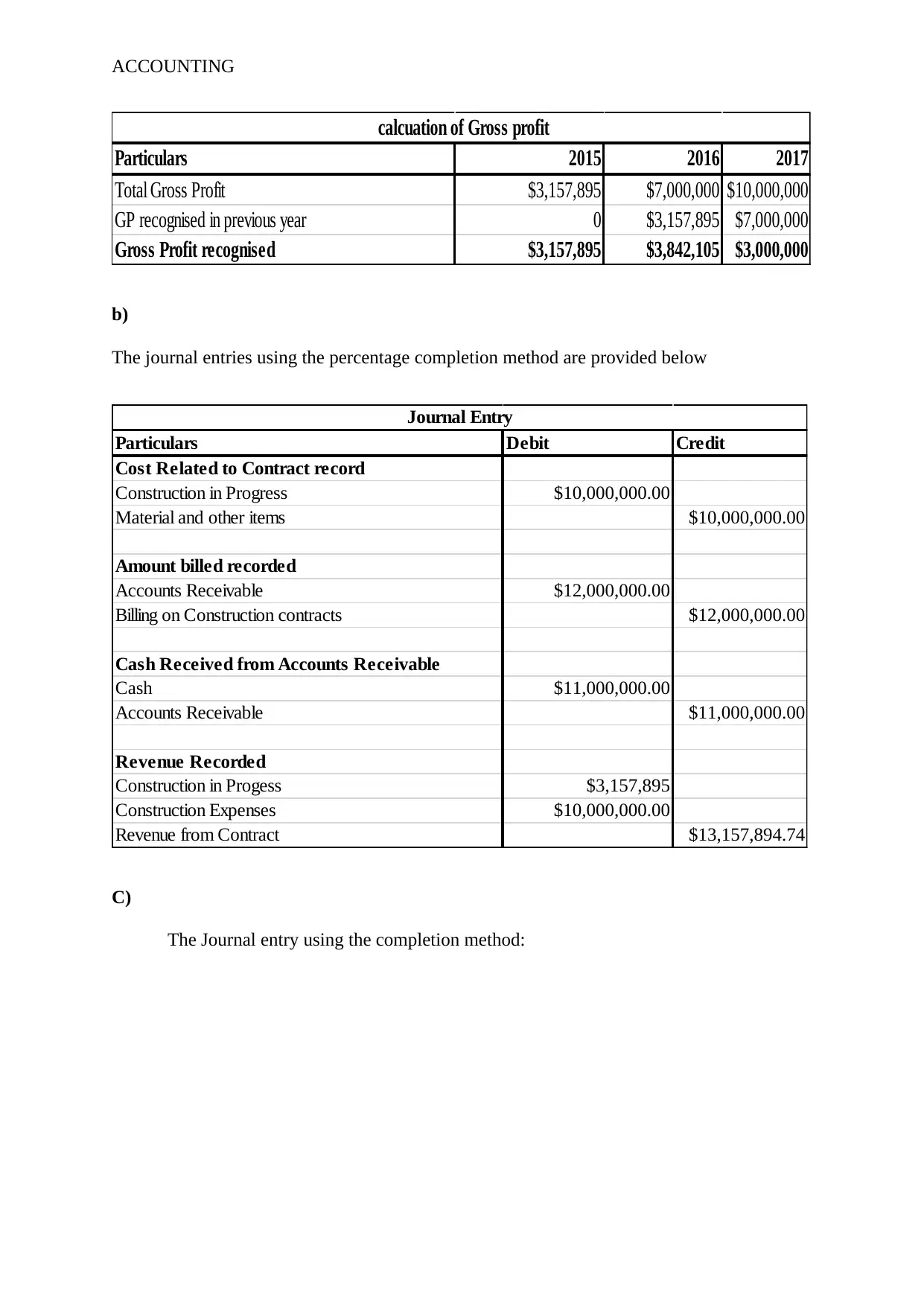
ACCOUNTING
Particulars 2015 2016 2017
Total Gross Profit $3,157,895 $7,000,000 $10,000,000
GP recognised in previous year 0 $3,157,895 $7,000,000
Gross Profit recognised $3,157,895 $3,842,105 $3,000,000
calcuation of Gross profit
b)
The journal entries using the percentage completion method are provided below
Particulars Debit Credit
Cost Related to Contract record
Construction in Progress $10,000,000.00
Material and other items $10,000,000.00
Amount billed recorded
Accounts Receivable $12,000,000.00
Billing on Construction contracts $12,000,000.00
Cash Received from Accounts Receivable
Cash $11,000,000.00
Accounts Receivable $11,000,000.00
Revenue Recorded
Construction in Progess $3,157,895
Construction Expenses $10,000,000.00
Revenue from Contract $13,157,894.74
Journal Entry
C)
The Journal entry using the completion method:
Particulars 2015 2016 2017
Total Gross Profit $3,157,895 $7,000,000 $10,000,000
GP recognised in previous year 0 $3,157,895 $7,000,000
Gross Profit recognised $3,157,895 $3,842,105 $3,000,000
calcuation of Gross profit
b)
The journal entries using the percentage completion method are provided below
Particulars Debit Credit
Cost Related to Contract record
Construction in Progress $10,000,000.00
Material and other items $10,000,000.00
Amount billed recorded
Accounts Receivable $12,000,000.00
Billing on Construction contracts $12,000,000.00
Cash Received from Accounts Receivable
Cash $11,000,000.00
Accounts Receivable $11,000,000.00
Revenue Recorded
Construction in Progess $3,157,895
Construction Expenses $10,000,000.00
Revenue from Contract $13,157,894.74
Journal Entry
C)
The Journal entry using the completion method:
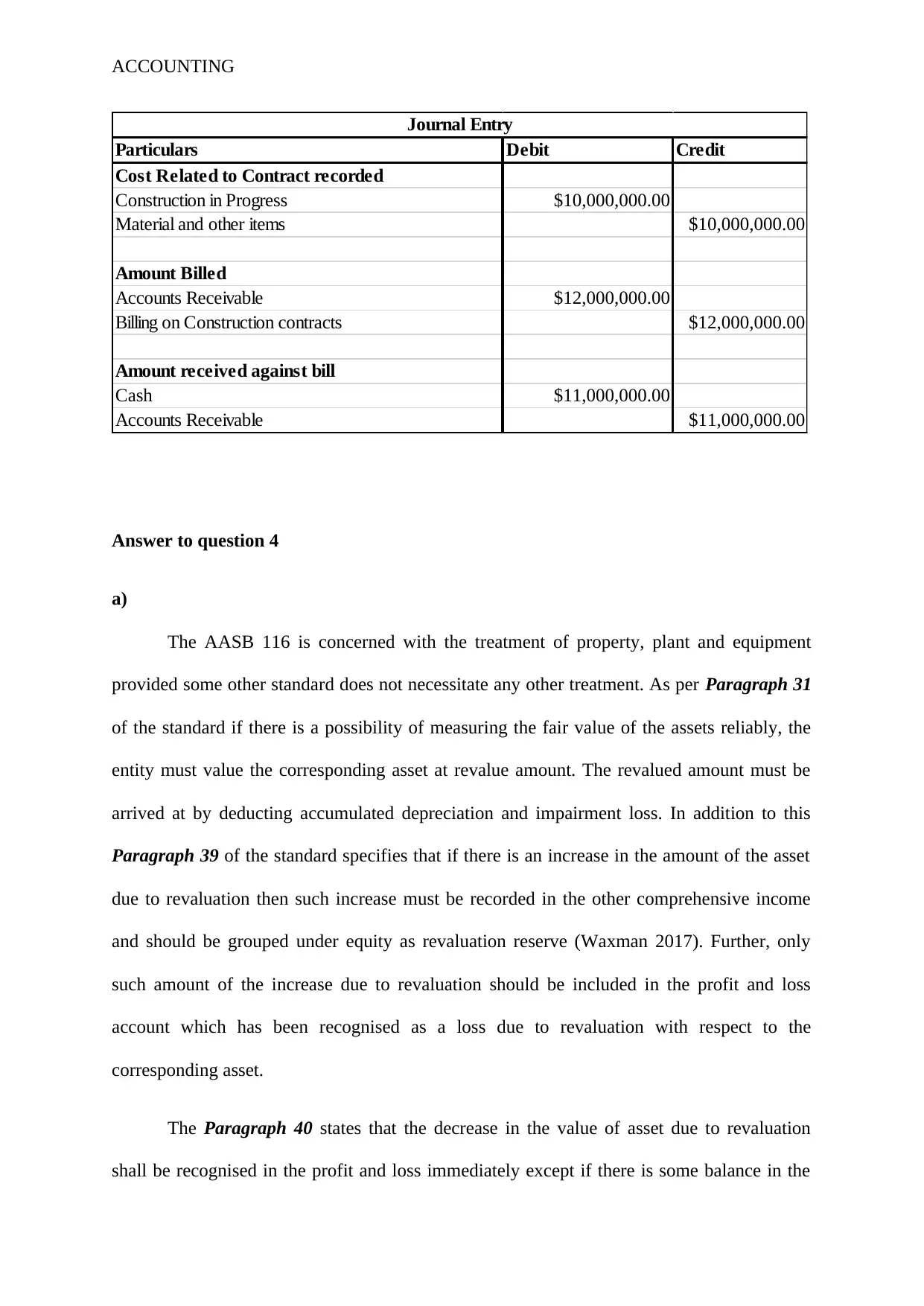
ACCOUNTING
Particulars Debit Credit
Cost Related to Contract recorded
Construction in Progress $10,000,000.00
Material and other items $10,000,000.00
Amount Billed
Accounts Receivable $12,000,000.00
Billing on Construction contracts $12,000,000.00
Amount received against bill
Cash $11,000,000.00
Accounts Receivable $11,000,000.00
Journal Entry
Answer to question 4
a)
The AASB 116 is concerned with the treatment of property, plant and equipment
provided some other standard does not necessitate any other treatment. As per Paragraph 31
of the standard if there is a possibility of measuring the fair value of the assets reliably, the
entity must value the corresponding asset at revalue amount. The revalued amount must be
arrived at by deducting accumulated depreciation and impairment loss. In addition to this
Paragraph 39 of the standard specifies that if there is an increase in the amount of the asset
due to revaluation then such increase must be recorded in the other comprehensive income
and should be grouped under equity as revaluation reserve (Waxman 2017). Further, only
such amount of the increase due to revaluation should be included in the profit and loss
account which has been recognised as a loss due to revaluation with respect to the
corresponding asset.
The Paragraph 40 states that the decrease in the value of asset due to revaluation
shall be recognised in the profit and loss immediately except if there is some balance in the
Particulars Debit Credit
Cost Related to Contract recorded
Construction in Progress $10,000,000.00
Material and other items $10,000,000.00
Amount Billed
Accounts Receivable $12,000,000.00
Billing on Construction contracts $12,000,000.00
Amount received against bill
Cash $11,000,000.00
Accounts Receivable $11,000,000.00
Journal Entry
Answer to question 4
a)
The AASB 116 is concerned with the treatment of property, plant and equipment
provided some other standard does not necessitate any other treatment. As per Paragraph 31
of the standard if there is a possibility of measuring the fair value of the assets reliably, the
entity must value the corresponding asset at revalue amount. The revalued amount must be
arrived at by deducting accumulated depreciation and impairment loss. In addition to this
Paragraph 39 of the standard specifies that if there is an increase in the amount of the asset
due to revaluation then such increase must be recorded in the other comprehensive income
and should be grouped under equity as revaluation reserve (Waxman 2017). Further, only
such amount of the increase due to revaluation should be included in the profit and loss
account which has been recognised as a loss due to revaluation with respect to the
corresponding asset.
The Paragraph 40 states that the decrease in the value of asset due to revaluation
shall be recognised in the profit and loss immediately except if there is some balance in the
Paraphrase This Document
Need a fresh take? Get an instant paraphrase of this document with our AI Paraphraser
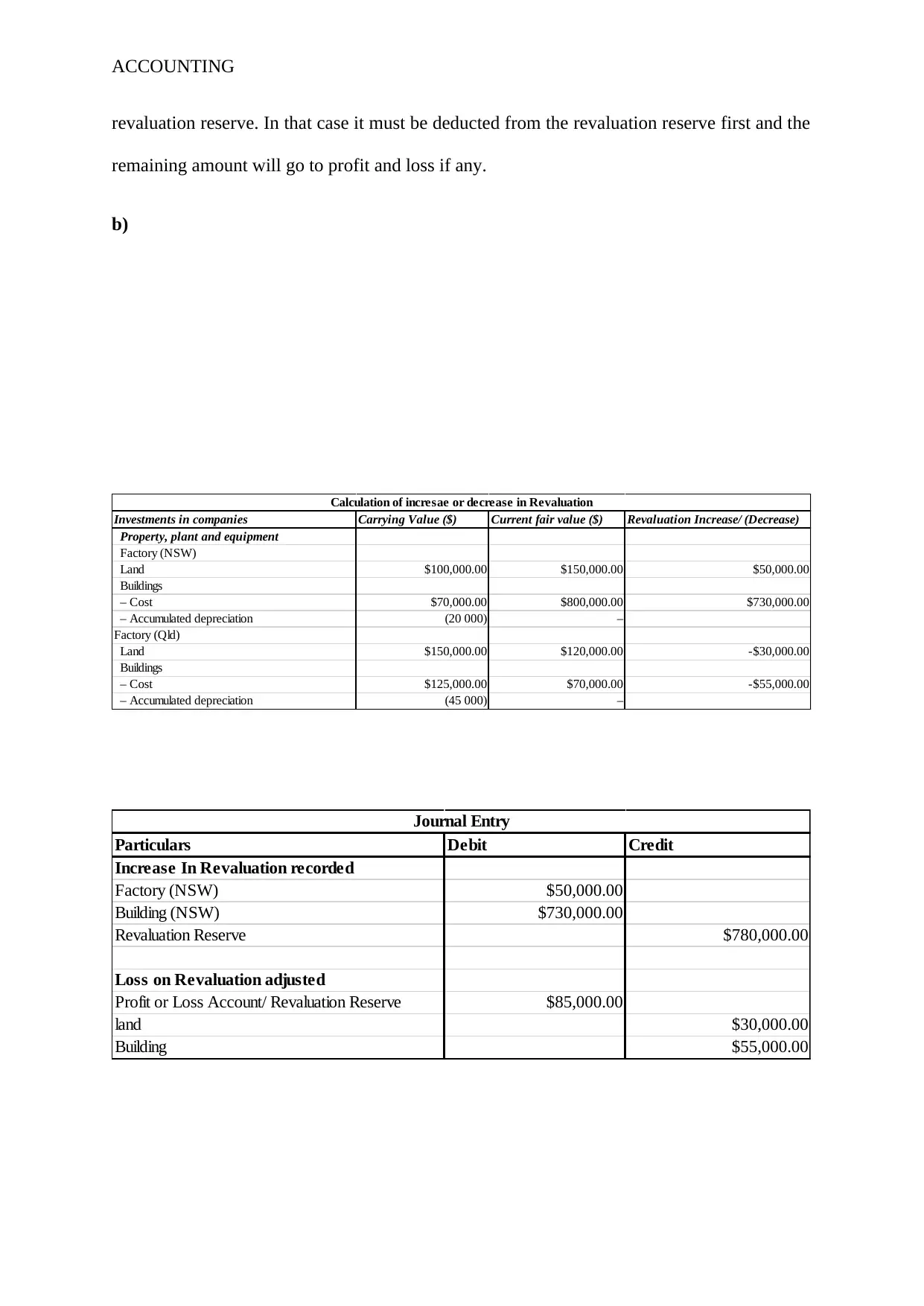
ACCOUNTING
revaluation reserve. In that case it must be deducted from the revaluation reserve first and the
remaining amount will go to profit and loss if any.
b)
Investments in companies Carrying Value ($) Current fair value ($) Revaluation Increase/ (Decrease)
Property, plant and equipment
Factory (NSW)
Land $100,000.00 $150,000.00 $50,000.00
Buildings
– Cost $70,000.00 $800,000.00 $730,000.00
– Accumulated depreciation (20 000) –
Factory (Qld)
Land $150,000.00 $120,000.00 -$30,000.00
Buildings
– Cost $125,000.00 $70,000.00 -$55,000.00
– Accumulated depreciation (45 000) –
Calculation of incresae or decrease in Revaluation
Particulars Debit Credit
Increase In Revaluation recorded
Factory (NSW) $50,000.00
Building (NSW) $730,000.00
Revaluation Reserve $780,000.00
Loss on Revaluation adjusted
Profit or Loss Account/ Revaluation Reserve $85,000.00
land $30,000.00
Building $55,000.00
Journal Entry
revaluation reserve. In that case it must be deducted from the revaluation reserve first and the
remaining amount will go to profit and loss if any.
b)
Investments in companies Carrying Value ($) Current fair value ($) Revaluation Increase/ (Decrease)
Property, plant and equipment
Factory (NSW)
Land $100,000.00 $150,000.00 $50,000.00
Buildings
– Cost $70,000.00 $800,000.00 $730,000.00
– Accumulated depreciation (20 000) –
Factory (Qld)
Land $150,000.00 $120,000.00 -$30,000.00
Buildings
– Cost $125,000.00 $70,000.00 -$55,000.00
– Accumulated depreciation (45 000) –
Calculation of incresae or decrease in Revaluation
Particulars Debit Credit
Increase In Revaluation recorded
Factory (NSW) $50,000.00
Building (NSW) $730,000.00
Revaluation Reserve $780,000.00
Loss on Revaluation adjusted
Profit or Loss Account/ Revaluation Reserve $85,000.00
land $30,000.00
Building $55,000.00
Journal Entry

ACCOUNTING
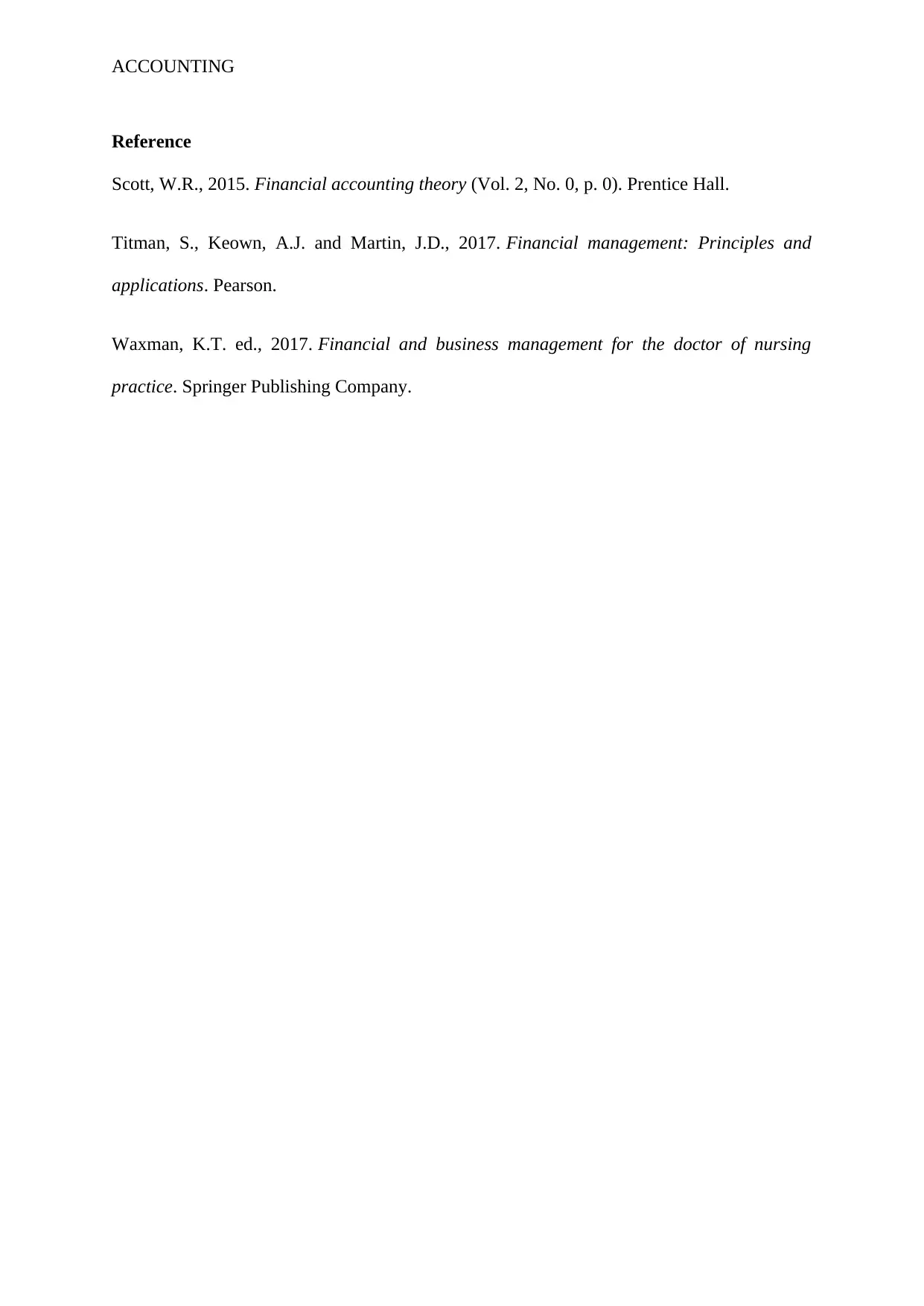
ACCOUNTING
Reference
Scott, W.R., 2015. Financial accounting theory (Vol. 2, No. 0, p. 0). Prentice Hall.
Titman, S., Keown, A.J. and Martin, J.D., 2017. Financial management: Principles and
applications. Pearson.
Waxman, K.T. ed., 2017. Financial and business management for the doctor of nursing
practice. Springer Publishing Company.
Reference
Scott, W.R., 2015. Financial accounting theory (Vol. 2, No. 0, p. 0). Prentice Hall.
Titman, S., Keown, A.J. and Martin, J.D., 2017. Financial management: Principles and
applications. Pearson.
Waxman, K.T. ed., 2017. Financial and business management for the doctor of nursing
practice. Springer Publishing Company.
1 out of 10
Related Documents
Your All-in-One AI-Powered Toolkit for Academic Success.
+13062052269
info@desklib.com
Available 24*7 on WhatsApp / Email
![[object Object]](/_next/static/media/star-bottom.7253800d.svg)
Unlock your academic potential
© 2024 | Zucol Services PVT LTD | All rights reserved.





